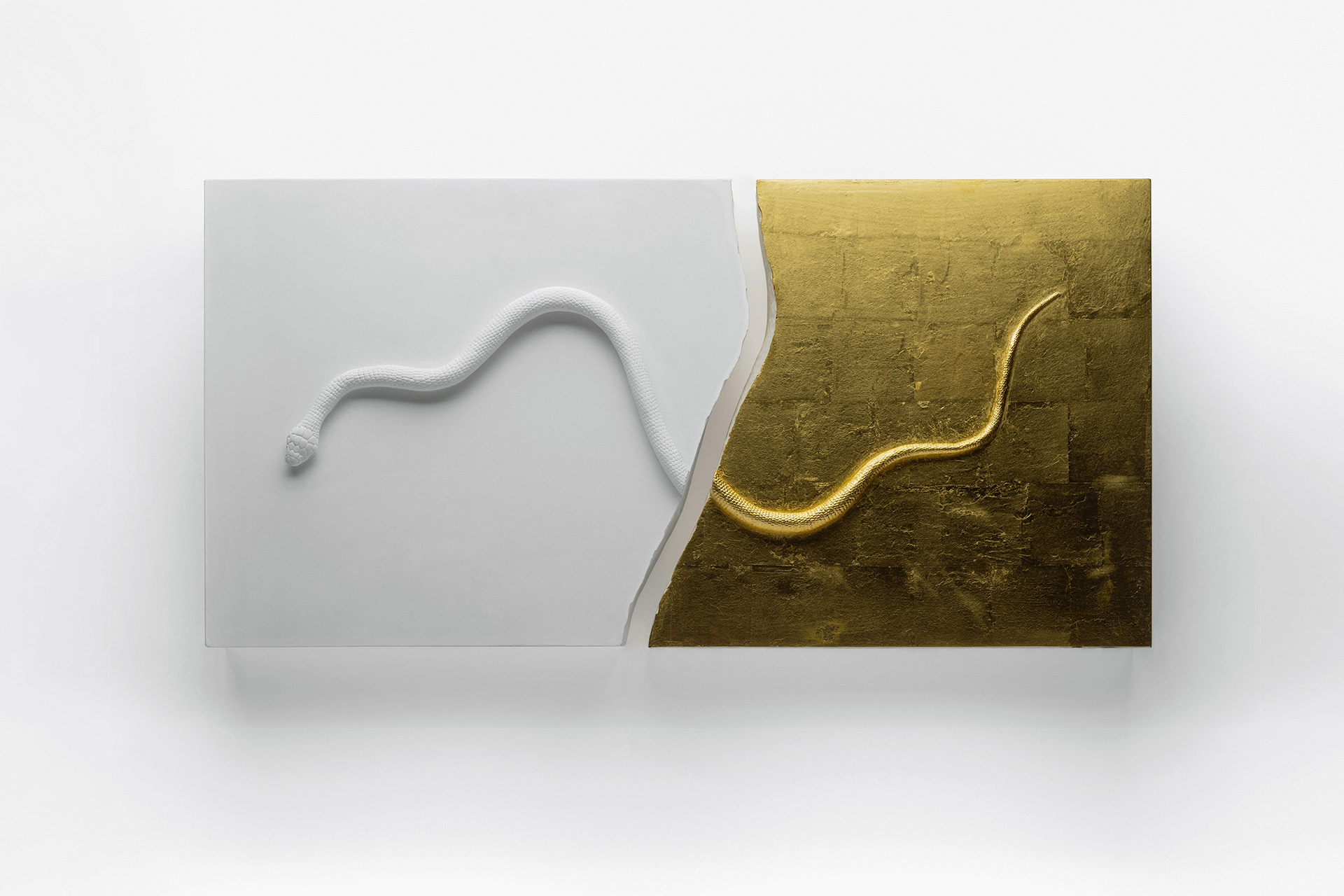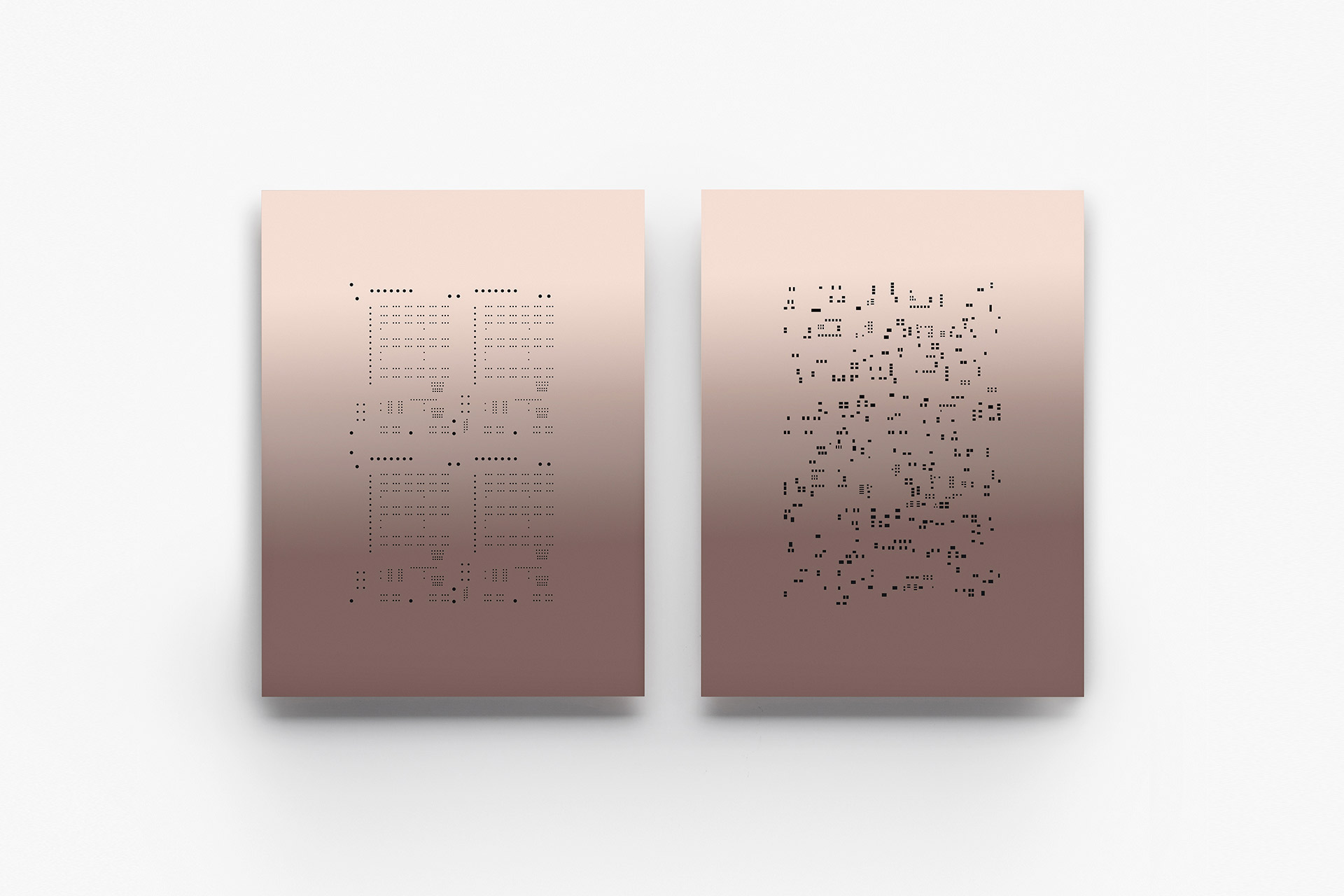

HUMAN CODE is a project on the relationship between humans and technology interpreted in relation to key terms like nature and artifice and exposed to the influence of specific arguments like experimentation with generative processes and analysis of data flows.
The project theorizes an eternal Anthropocene governed by the oversight of human design activity and traces some of the most important stages of human evolution in a dense sedimentation that spans 600,000 years.
HUMAN CODE materializes through a series of powerful and mysterious post-archaeological artifacts, which seem to re-emerge in a distant future where the artificial and natural components are stratified together in an indissoluble way.

HUMAN CODE develops through a body of ten works.
Idol of Domestication is a sculpture made of cast bronze with black onyx inserts: it metaphorically alludes to the process of genetic mutation of foods induced by humans, beginning in the Neolithic age and still in progress. The “corn idol” is the result of a domestication obtained by crossing various “teosintes” - forerunners of corn - to boost production capacity and to satisfy the nutritional needs of communities.
Archaic Future is a series of five bronze castings - taken from molds sculpted by hand in wax by the designer - that reproduces different flints, the first utensil-weapon of humans and an indispensable object to trigger the revolution of fire, suggested here by three pieces shaped in wax of “The Invention of Fire”.
 HUMAN CODE, Archaic Future
HUMAN CODE, Archaic Future
 HUMAN CODE, Idol of Domestication
HUMAN CODE, Idol of Domestication

 HUMAN CODE, the Invention of Fire
HUMAN CODE, the Invention of Fire
Disappearing and Broken Myth form a diptych of great evocative force focusing on the ancestral humans-non humans relationship: the first piece in cast aluminium addresses the risk of extinction of bees in the earth’s ecosystem due to climate change, reduction of biodiversity and the overwhelming pollution created by the action of human beings; the second reflects on the loss of the magical-mythological aura attributed to animals in antiquity, irremediably broken down by the rational thinking implicated in scientific postulates of the 18th century.
 HUMAN CODE, Broken Myth
HUMAN CODE, Broken Myth
 HUMAN CODE, Disappearing
HUMAN CODE, Disappearing

Human Code, the work that gives name to the whole project, is a totemic fragment of stone which bears the inscription of the algorithm used for the extraction of the electrocardiographic signal that translates the electric impulses of the heart in a human-readable graph, written in the C++ programming language.
The menhir in serpentine stone is installed at the geometric center of a radial array of seven prisms hewn from the same rock, creating a ritual architecture of primordial type - with an esoteric-expressive signifying role.
The neon installation Rutor Glacier examines the alarming reduction of volume - expressed in millions of cubic meters - of the Italian Rutor glacier in Valle d’Aosta, based on the difference of measurement between the end of the so-called “Little Ice Age” (1850 circa) and the monitoring conducted by the Italian Glaciological Committee in 2004.



 HUMAN CODE, Rutor Glacier
HUMAN CODE, Rutor Glacier
In Digital Venus the reasoning again focuses on the eloquent encounter and clash between the extremes of archaic-primitive and contemporary-futuristic: a six-axis robot arm receives instructions to replicate the Venus of Lespugue, a Paleolithic statuette dating back to about 25,000 years ago, sculpted by our ancestor as a fetish of worship of the feminine principle in a matrifocal society.
Traces consists of four rectangular copper panels that reproduce four different stencils for the production of printed circuit boards, the heart of the electronic devices we use every day and with which we communicate.
 HUMAN CODE, Digital Venus
HUMAN CODE, Digital Venus


 HUMAN CODE, Traces
HUMAN CODE, Traces
The project, like the pathway and narrative it implies, is completed and concluded by Untitled; a human tibia sculpted in alabaster links back to the famous initial scene known as “The Dawn of Man” of the film by Stanley Kubrick “2001: A Space Odyssey”. The bone, a passive material - if seen as human remains - but also active - if imagined as a potential utensil - is the emblematic semblance of a primary determinate cultural and technological object.
 HUMAN CODE, Untitled
HUMAN CODE, Untitled
Harari, Yuval Noah. Sapiens:A Brief History of Humankind. Harvill Secker, 2014
Diamond, Jared. Guns, Germs, and Steel: The Fates of Human Societies. W W Norton & Co Inc, Edition, 2005
Demos, T. J. Against the Anthropocene Visual Culture and Environment Today. Sternberg Press, 2017
Lowenhaupt Tsing, Anna. The Mushroom at the End of the World: On the Possibility of Life in Capitalist Ruins.Princeton University Press, 2017
Mazoyer, Marcel; Roudart, Laurence. A history of world agriculture: from the neolithic age to the current crisis. NYU Press, 2006
Kohn, Eduardo. How Forests Think: Toward an Anthropology Beyond the Human. University of California Press, 2013
Attali, Jacques. L’uomo nomade. Spirali, 2006
de Castro, Eduardo Viveiros; Danowski, Deborah. The Ends of the World. Polity, 2016
Turpin, Etienne. Architecture in the Anthropocene: Encounters Among Design, Deep Time, Science and Philosophy.Open Humanities Press, 2013
Burtynsky, Edward; Baichwal, Jennifer; de Pencier, Nicholas. Anthropocene. Steidl, 2018
Kolbert, Elizabeth. The sixth extinction: An unnatural history. A&C Black, 2014
Mancuso, Marco. Arte, tecnologia e scienza: leart industries e i nuovi paradigmi di produzione nella new media art contemporanea. Mimesis, 2018
Branzi, Andrea; Hara, Kenya. "Neo Preistoria: 100 Verbi." Milano: XX1T, 2016
Morton, Timothy. Philosophy and Ecology after the End of the World. Columbia University Press, 2013.
Colomina, Beatriz; Wigley, Mark. Are we Human?. Lars Müller Publishers, 2016.
Braidotti, Rosi; Hlavajova, Maria. Posthuman Glossary. Bloomsbury Publishing, 2018
Hanson, Thor. The triumph of seeds. Basic Books, 2015
Aloi, Giovanni. Speculative Taxidermy: Natural History, Animal Surfaces, and Art in the Anthropocene. Columbia University Press, 2018
Haraway, Donna. Staying with the trouble: Making kin in the Chthulucene. Duke University Press, 2016.
Clement, Gilles. Manifesto del terzo paesaggio. Quodlibet, 2004
Turpin, Etienne and Davis Heather. Art in the Anthropocene: Encounters among aesthetics, politics, environments and epistemologies. Open Humanities Press, 2015.
Latour, Bruno. Facing Gaia: Eight Lectures on the New Climatic Regime. Wiley, 2017
Ghosh, Amitav. The Great Derangement. Climate Change and the Unthinkable. University of Chicago Press, 2017
Fusillo, Massimo. Feticci: letteratura, cinema, arti visive. Il mulino, 2012
Caffo, Leonardo. Fragile umanità. Il postumano contemporaneo. Einaudi, 2017
McNeill, J. R.; Engelke, Peter. The Great Acceleration: An Environmental History of the Anthropocene since 1945. Belknap Press: An Imprint of Harvard University Press, 2016
Arkesteijn, Ed Roel. The Incomplete Writings Of Mark Dion - Selected Interviews, Fragments And Miscellany. Fieldwork Museum, 2018
Griffin, Neil. Biodiversity Loss in the 21st Century. Callisto Reference, 2015
Coccia, Emanuele. The Life of Plants: A Metaphysics of Mixture. Polity Press, 2018